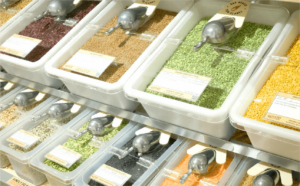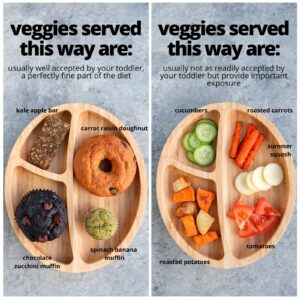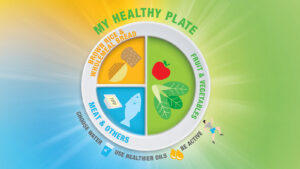
(Credits: Shutterstock)
It’s a cycle we’ve all gone through at least once in our lives.
We resolve to eat healthier, then fall to temptations and say, “Never mind, the diet can start tomorrow,” right?
Healthy eating is something easier said than done.
We fall for the temptations of the ease, low price, and convenience of hawker food over healthy, home-cooked food for us and our family.
With our busy lifestyles, healthy eating usually does not top our list of priorities.
But what about our children?
In 2021, nearly 1 in 5 Singaporean children (aged 0–14 years old) were obese!
While it isn’t as high as in other countries, the number is still on the rise, and obesity could affect your child’s life in more ways than one and have lasting impacts throughout their life.
So it is important to develop healthy eating habits and preferences in your child’s developing years that will last them for life.
Building Healthy Habits

(Credits: DreamsTime)
Let’s ditch this whole “Aw man, healthy eating is so hard” thing. It doesn’t have to be if you don’t make it out that way in your head!
Instead, we’ll turn choosing healthy eating into habits that you do without thinking.
A habit is defined as “A usual way of behaving: something that a person does often in a regular and repeated way.”
Therefore, the easiest way to mould your and your child’s mindset towards healthy eating and living is to make it habitual.
As a parent, it is easy for you to surround your children in an environment that shapes their views and tastes.
Think about it this way. Your child develops a liking for baked potatoes. So they’re not going to choose another form of potato, like french fries, over baked potatoes. Just like how they’ll always choose their favourite pyjamas over another one.
The Benefits of Instilling Healthy Eating Habits in Childhood

(Credits: Shutterstock)
I’m sure you don’t need me to tell you about the countless benefits of eating healthy, but here are some holistic benefits that your child will experience when healthy eating habits are ingrained in them.
However, let me begin with the hard, unpleasant truth.
A local study between the A-Star Group and local health institutions found that eight-year-old children showed a high risk for pre-hypertension and had higher levels of sugar and fat in their blood!
These children were less active and had a low intake of fruits and vegetables, along with a high intake of processed sugar and unhealthy food.
Instead, if your child grows up eating healthy, they’ll develop properly, and holistically. They’ll likely have a healthy relationship with food, go through proper physical development, and have better health.
Your children will learn discipline, self-respect, and responsibility when they grow up with healthy habits.
Beyond childhood, these habits will likely be the foundation of their eating and living habits too..
How To Instill Healthy Eating Habits + Tips To Get Your Child To Eat Veggies
-
Be a Role Model

(Credits: Health Hub)
Monkey see, monkey do.
Children pick up behaviours by watching and listening to others. By being the first role model in your child’s life, you will be the first person they look to for what’s right and wrong.
-
Follow The 80-20 Rule.

(Credits: DMoose)
With the 80-20 rule, you and your child will eat healthily on the weekdays (80%) and can treat yo’ selves (20%) on the weekends! What a balanced life!
-
Do Not Keep Unhealthy Snacks At Home.

(Credits: The Inspired Home)
Out of sight, out of mind. You and your child can’t get tempted and reach for a bag of chips or candy at home if there aren’t any!
-
Avoid Processed sugar.

Processed sugar has been proven to do more harm than good to anyone.
It’s literally the junk food of the sugar world! Filled with empty calories and no nutrients, it doesn’t offer anything good for your child’s development.
However, processed sugar is not the same as natural sugar that’s in fruits. The former is the sugar world’s junk food. While filled with fibre, vitamins, and minerals; natural sugar is like their whole-grain bread.
-
Try Different Methods, Cuisines, and Flavours.

(Credits: My Pure Plants)
Don’t be afraid to switch things up during meal times! Who wants to eat the same stir-fried broccoli with mushrooms three times a week? Your child would probably get tired of the same Peperoni pizza if they ate it every day too.
So experimenting with dishes from different cuisines will switch things up for your child while helping them learn and appreciate other cultures as well!
- Reach for Whole Ingredients.

(Credits: SCOOP Wholefoods Singapore)
Whole ingredients are anything, as the name suggests, whole and not processed. Because they’re whole, they retain their nutrients as much as possible without any added yuckies.
Don’t worry about labels like ‘organic’, ‘non-GMO’, blah blah blah. As long as they’re fresh, is all that matters!
-
Hidden Veggies

(Credits: cait’s plate)
Mashed beans in brownies, cauliflower in frosting, and blending veggies into tomato sauce?
It might sound gross. But hiding veggies is the trick parents are turning to to sneak more vegetables into their children’s food while fortifying their meals with more nutrients!
But it can’t all be fruit-filled smoothies or veggie-packed muffins. It’s still important to teach your child to eat and appreciate whole vegetables.
If you’re clueless on where to begin, there are countless recipes out there where fruits and vegetables can be used to replace fat, eggs, or added processed sugar in baked goods!
-
Involve Your Child

(Credits: Shutterstock)
I remember getting excited for dinner as a child when my Mum asked me to help her in the kitchen, and I would always gobble up whatever we made. Even if it wasn’t that good. (sorry Mum).
Letting your kids have fun in the kitchen and getting their hands dirty while spending time with you will give them good memories about food and cooking.
It might also get the picky eaters to eat their peas and carrots. Score!
Maintaining a Healthy Mindset and Relationship With Food

As with anything, balance is key. Just like how cake every day isn’t healthy, having salad for every meal isn’t healthy either.
You wouldn’t want years of excessively restricting your child to turn into disordered eating habits in the future.
There’s No Good or Bad in Food!

So ditch the ‘good food’, and “bad food’ label too. This puts negative connotations on food and might send the wrong message to your child.
Remember that no food is inherently bad. A cheeseburger dissected is just beef, bread, lettuce, tomatoes, cheese, and sauce, right?
Food Is A Right, Not A Privilege

Do not use food to reward your children too. Teaching your child to “work for food” is not a good lesson or habit to have.
Most importantly, do not ever shame their body or make them feel guilty for eating a specific food.
Instead, teach your child that food should be consumed for energy, nutrition, and nourishment. It isn’t a “reward” to be earned either.
Size Matters Too

(Credits: Health Hub)
It’s not just quality, but quantity too. Eating 1 kg of broccoli is unhealthy, you know! So use visual tools like ‘My Healthy Plate’ to teach them about proper portion sizes.
Lastly, they should learn how to listen to their body and eat intuitively. “Eat when you’re hungry and stop when you’re full or satisfied.” Leftovers can be kept away and finished at a later time if food waste is a worry of yours.
Conclusion

(Credits: FreePik)
Healthy eating and living don’t have to be hard if you make it a thing of habit for your children.
They say it takes 30 days to nip a bad habit, 66 days to turn it into a habit, and 90 days to make it a permanent lifestyle change.
So see healthy habits as a continuous journey to the end goal of good health.
Imagine your child experiencing the holistic benefits that healthy eating brings, and it’s definitely worthy of the time and effort you’ll be investing into it.
So hang in there, think about your child’s future, and do not give up. You’ve got this!
And if your child has trouble in school too, contact SmileTutor to be in touch with a world-class tutor for your child today!
